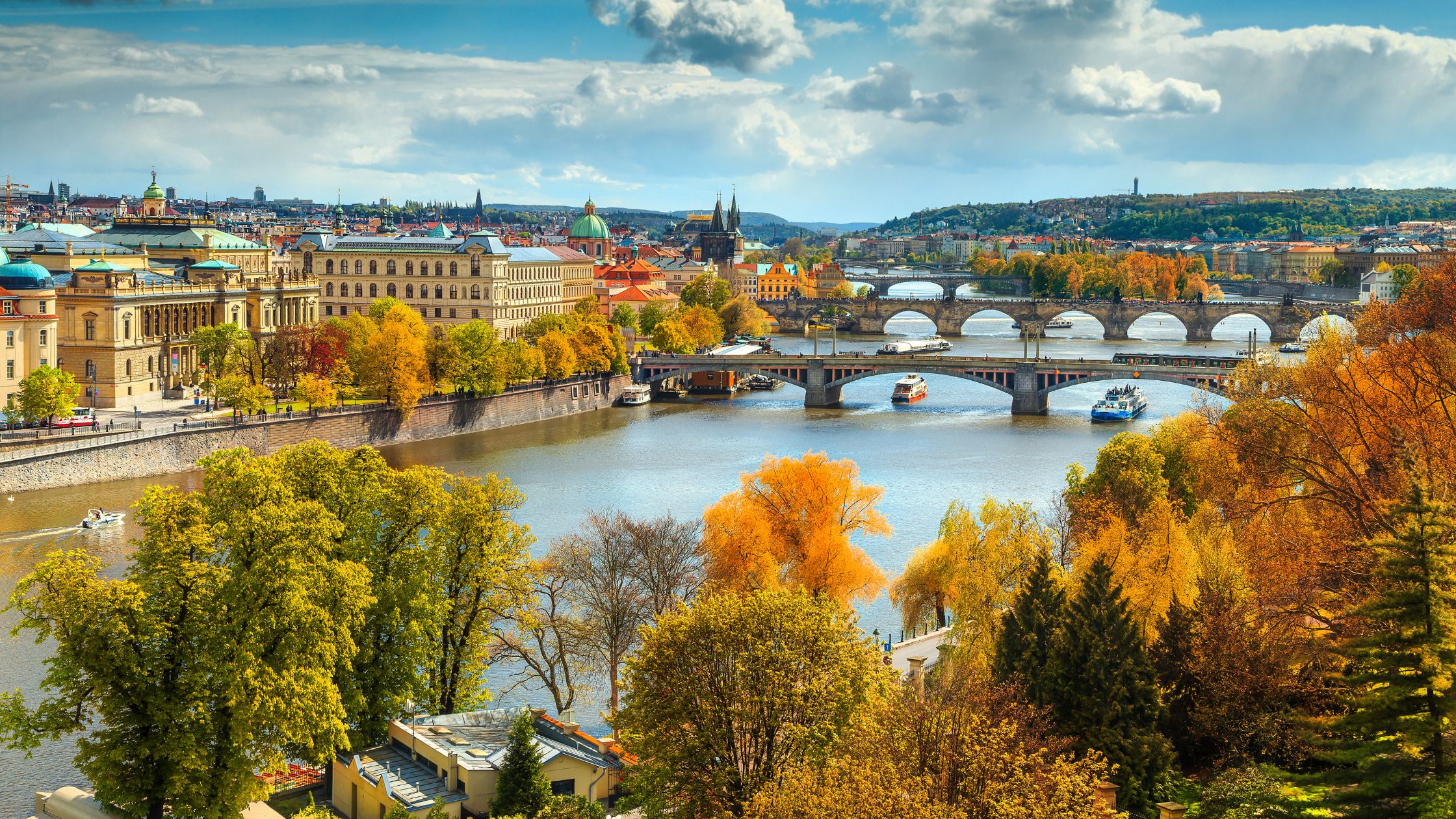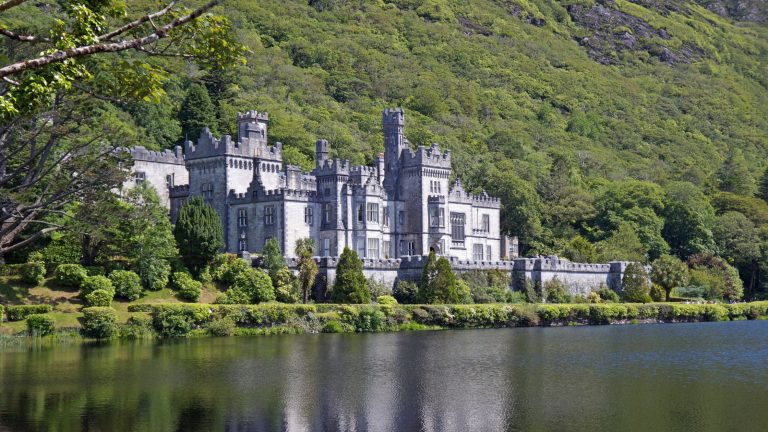Orchestrating Your Perfect Czech Symphony Through Seasons and Lakeshores
Picture yourself gliding across Lipno Lake’s crystalline surface at dawn, the Bohemian Forest reflected in waters so still they mirror clouds like a Renaissance ceiling fresco, while medieval spires of Český Krumlov pierce morning mist just kilometers away.
Now reimagine this scene through the Czech Republic’s seasonal kaleidoscope—frozen beneath January’s crystalline grip when cross-country skiers trace shoreline paths, exploding with July’s festival energy when paddleboards dot the surface like scattered petals, or painted October gold when Signal Festival transforms Prague’s stones into canvases of light. The Czech Republic doesn’t merely change with seasons; it metamorphoses completely, offering entirely different countries depending on when you arrive at its castle gates, vineyard valleys, and lakeside sanctuaries.
Your perfect Czech moment awaits somewhere between Prague Spring’s classical crescendos echoing through baroque halls and December’s glühwein warming your hands at Old Town Square’s Christmas market.
Whether you’re drawn to Mácha Lake’s summer swimming pleasures, the Moravian wine trails’ September harvest celebrations, or Špindlerův Mlýn’s powder-perfect slopes, understanding Czech Republic’s temporal rhythms transforms good trips into transcendent journeys.
Let’s navigate this Central European jewel’s calendar together, revealing when lakes sparkle brightest, when castle crowds thin to whispers, and when your travel investment yields maximum cultural dividends.
What Months Deliver Czech Republic’s Perfect Balance?
May-June and September: The Golden Windows
Czech Republic reaches its zenith when spring fully blooms and summer gently retreats, creating two golden windows that locals guard jealously. May arrives with temperatures climbing from 17-23°C, transforming Prague’s Petřín Park into an impressionist painting of cherry blossoms while Lipno Lake awakens from winter’s slumber. The Prague Spring International Music Festival (mid-May through early June) fills concert halls with world-class performances, yet Charles Bridge remains navigable at dawn when only photographers and early joggers share your solitude.
June extends this magic with 20-26°C days stretching past 9 PM, when Smetana Litomyšl opera performances spill into Renaissance courtyards and Mácha Lake reaches swimmable temperatures. “June is when Czech Republic remembers why we live here,” shares Pavel Novák, who operates paddleboard rentals at Lipno Lake. “The water is finally warm enough for comfortable swimming, cycling paths through the Bohemian Forest are dry, and you can still find parking at the Treetop Walkway without the July madness.”
September emerges as Czech Republic’s best-kept seasonal secret, when temperatures hover between 18-24°C and the entire country transforms into a harvest celebration. The vinobraní (wine harvest) festivals in Mikulov, Znojmo, and Mělník create authentic cultural immersion impossible during summer’s tourist tide. Dvořák Prague Festival brings classical music back to the capital’s concert halls, while Bohemian Switzerland’s sandstone formations glow golden in autumn’s oblique light. Lakes retain enough summer warmth for afternoon paddles, though smart travelers pack light jackets for evening terrace dining.
Peak Season Realities: July-August Intensity
Summer’s crescendo brings undeniable pleasures—Lipno Lake reaches its annual peak of 22°C, every beer garden buzzes with energy, and festival season reaches maximum velocity. The Karlovy Vary International Film Festival (early July) transforms the spa town into Central Europe’s Cannes, while Colours of Ostrava (mid-July) converts a former steelworks into a multi-stage musical wonderland. International Music Festival Český Krumlov stages world-class performances in UNESCO-protected courtyards throughout July and August, creating cultural moments impossible to replicate elsewhere.
Yet this popularity demands strategic navigation. Prague’s Old Town Square and Charles Bridge become human rivers by midday, Český Krumlov’s narrow lanes reach capacity, and lakeside accommodations command premium rates. Smart summer travelers adapt through timing and geography: exploring Prague Castle at 9 AM opening, shifting midday hours to Lipno’s cooling waters or Mácha Lake’s shaded shores, and discovering that Třeboň’s pond region offers similar aquatic pleasures without Lipno’s crowds.
How Do Czech Seasons Transform Your Experience?
Spring’s Awakening: April Through June
Spring arrives unevenly across Czech Republic’s diverse topography, creeping from Moravian vineyards’ early April buds to Krkonoše Mountains’ late May wildflowers. April brings 12-18°C days perfect for castle exploration—Karlštejn, Konopiště, and Křivoklát open extended hours while tour buses remain garaged. The Moravian Karst caves near Blansko reveal their subterranean rivers via boat, while Punkevní Cave’s underground lake creates natural theater that stays constant at 8°C regardless of surface weather.
May elevates everything: Lednice-Valtice cultural landscape explodes with Renaissance garden geometry, South Moravian cycling paths wind through awakening vineyards, and Lipno Lake’s 1,200-meter Treetop Walkway (Stezka korunami stromů) offers canopy views across three countries on clear days. Prague’s river islands—particularly Střelecký ostrov—become outdoor galleries where locals picnic beneath willows while Vltava River cruise boats begin their summer schedules.
Summer’s Full Embrace: July Through August
Czech summer arrives with continental certainty—temperatures climbing to 24-31°C, transforming every body of water into a magnet for heat-weary souls. Lipno Lake, Czech Republic’s largest reservoir at 48 square kilometers, becomes the nation’s aquatic playground. The Lipno Bike Park’s chairlift-accessed trails satisfy adrenaline seekers, while families gravitate toward shallow swimming areas and pedal boat rentals. Mácha Lake, immortalized in romantic poetry as “Czech Republic’s sea,” draws Prague weekenders to its sandy beaches and surrounding pine forests.
August intensifies the lakeside culture with water temperatures peaking and every shoreline restaurant extending hours past midnight. The Třeboň pond region—a UNESCO Biosphere Reserve with 460 interconnected ponds—offers quieter alternatives where carp farming traditions dating to the 14th century continue alongside modern cycling infrastructure. Evening castle performances at Český Krumlov and Lednice create magical moments when baroque music floats across water gardens illuminated by torches and spotlights.
Autumn’s Golden Performance: September Through November
Autumn transforms Czech Republic into a photographer’s paradise where every surface seems gilded. October’s Signal Festival turns Prague into an open-air gallery of light installations, with projections transforming Gothic facades into living art while crowds move between installations like cultural pilgrims. The Bohemian Paradise (Český ráj) and Křivoklátsko forests reach peak color, creating hiking conditions that rival New England’s famous foliage.
Wine harvest season defines September’s character across South Moravia, where the Moravian Wine Trails’ 1,200 kilometers connect cellars, châteaux, and cycling paths through undulating vineyard landscapes. November brings contemplative pleasures—museum halls empty of summer crowds, spa colonnades in Karlovy Vary and Mariánské Lázně echo only with fountain music, and hotel rates drop to annual lows just before Christmas market season begins.
Winter’s Surprises: December Through March
Czech winter splits between festive December markets and January-March’s genuine cold season. Prague’s Christmas markets transform five major squares into wooden village wonderlands from late November, with Old Town Square’s towering tree and hourly astronomical clock performances creating Instagram moments multiplied infinitely. Brno, Olomouc, and Český Krumlov offer smaller-scale magic without Prague’s weekend crowds.
The Krkonoše Mountains become Czech Republic’s winter sports capital, with Špindlerův Mlýn and Pec pod Sněžkou offering surprisingly sophisticated skiing just two hours from Prague. The Jizerská 50 cross-country race (early February) draws thousands to the Jizera Mountains’ groomed trail network. Yet winter’s greatest pleasure might be simpler: soaking in Karlovy Vary’s thermal pools while snow falls, creating that perfect contrast between body warmth and air chill that defines Central European spa culture.
Where Do Czech Lakes Create Their Perfect Moments?
Lipno Lake: South Bohemia’s Aquatic Kingdom
Lipno Lake stretches along the Austrian border like an inland sea, its construction in the 1950s creating Czech Republic’s largest water playground while somehow maintaining ecological integrity. Summer transforms Lipno into Central Europe’s lake district, where morning mist creates mystical atmospheres perfect for sunrise SUP sessions, while afternoon thermals provide consistent sailing winds. The lake’s irregular shoreline creates countless coves and inlets, each offering different experiences—from family-friendly beaches near Lipno nad Vltavou to wild swimming spots accessible only by boat or forest trail.
The surrounding Šumava National Park elevates Lipno beyond mere water recreation. The Treetop Walkway spirals 40 meters above the forest canopy, culminating in a viewing tower where Alps pierce the horizon on clear days. Cycling paths circle the entire lake—48 kilometers of varying difficulty that connect medieval monasteries, contemporary art installations, and waterfront restaurants where fresh-caught pike-perch arrives with Bohemian Forest mushrooms.
Mácha Lake: Romantic and Serene
Mácha Lake’s sandy beaches, unusual for landlocked Czech Republic, create genuine seaside atmospheres complete with beach volleyball, wind-surfing schools, and ice cream vendors. Summer weekends see the lake surrounded by a tent city of Prague escapees, yet early mornings and September weekdays reveal mist-shrouded castle ruins reflected in still water, pine forests exhaling resin perfume, and silence broken only by swan wings cutting through surface tension.
When Should You Plan Around Czech Republic’s Cultural Calendar?
Czech Republic’s festival calendar provides anchors for memorable journeys. The Prague Spring International Music Festival (mid-May through early June) ranks among Europe’s most prestigious classical events, with performances in venues ranging from Rudolfinum’s Art Nouveau splendor to St. Vitus Cathedral’s Gothic acoustics. Karlovy Vary International Film Festival (early July) transforms the spa town into a celebrity-filled screening paradise where thermal springs provide recovery between premieres.
Colours of Ostrava (mid-July) deserves special mention—a former coal mine and steelworks converted into one of Europe’s most dramatic festival venues, where 20 stages host everything from world music to experimental electronica. The wine harvest festivals throughout September—particularly Mikulov and Znojmo’s elaborate celebrations—combine Renaissance pageantry with serious viticulture, creating experiences that feel simultaneously touristy and authentic.
Your Perfect Czech Moment Awaits
Czech Republic rewards thoughtful timing with experiences that transcend typical Central European holidays. Choose May or September for that perfect synthesis of comfortable weather, cultural richness, and breathing room at major attractions. Embrace July-August if lakes and festivals define your priorities, but prepare for crowds with early starts and strategic geography. Consider December for markets that rival Vienna’s, or January-March for spa indulgence and surprising ski quality.
Through Lake.com, we’ll orchestrate your Czech journey with precision, ensuring lakeside accommodations at Lipno or Mácha align with your interests, whether that’s SUP at sunrise, wine harvest celebrations, or Signal Festival’s luminous October evenings. Czech Republic doesn’t just change with seasons—it reveals entirely different personalities, each valid, each magical, each worthy of exploration. Your task is simply choosing which Czech Republic you want to meet first.






